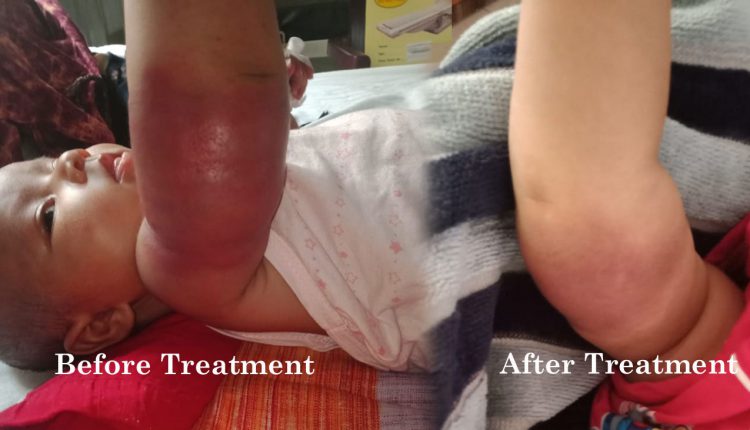A Rare Case of Kasabach-Merritt Syndrome Treated at Department of Pediatrics, KIMS
Kasabach-Meritt phenomenon (KMP) is a life threatening event with a triad of anemia, thrombocytopenia and coagulopathy. It was first described by Kasabach & Meritt in 1940. The tumors that are found to be associated with KMP are kaposiform hemagioendothelioma (KHE) and tufted angioma. More than 80 % of the cases manifest within the first year of life. Estimated mortality ranges from 10% to 37%. Mortality and morbidity are usually associated with internal organ involvement and hemorrhage due to marked thrombocytopenia and coagulopathy. Management strategies established till now are corticosteroids, chemotherapy, propranolol, embolization, laser therapy, radiation and/or surgery. The main aim is to control intravascular coagulopathy and to improve platelet counts, thereby preventing the major complications.
Case Presentation
A 2 months 5 days old female infant was presented in May 2022 to the Department of Pediatrics of Kalinga Institute of Medical Science (KIMS) with an erythematous lesion over right arm from day 10 of life, and increasing in size. It is not associated with a fever or localized rise of temperature, but associated with edematous change of right upper limb. The child was on regular check up, but in view of rapid progression of the lesion along with edema, she was referred to KIMS.
On admission the child was conscious, alert, febrile and playful. Normal vitals and systemic examination revealed no abnormality. Local examination of the right arm showed a hemangioma of size 8.5 cm × 14 cm. It is non tender, but associated with edema of right upper limb intact distal pulses. The skin above the lesion was reddish-violaceous with small petechiae, and had no signs of devitalisation.
The values of the laboratory parameters showed TLC: 18,600/cmm, Hb: 6.9gm%, TPC: 25000/cmm, and CPS shows microcytic hypochromic anemia with thrombocytopenia. The prothrombin time was 11.6 seconds, aPTT 25.8 secs, INR: 1.05, serum D-dimer: 13.23 ug/ml, and serum fibrinogen level was < 40 mg/dl. LFT & RFT parameters were within normal range. The USG abdomen & pelvis showed no normality.
Doppler study of right upper limb confirmed thickened heterogeneous soft tissue over the right arm, proximal forearm with prominent vessels showing arterial & venous flow with dilated vessels in subcutaneous plane & intramuscular plane with features suggestive of hemangioma/hemangioendothelioma.
A magnetic resonance imaging (MRI) examination revealed ill-defined T2/STIR hyperintense soft tissue thickening involving subdermal fat planes in arm and forearm.
A CT angiogram of the right upper limb showed ill defined dense, soft tissue thickening skin & the subcutaneous plane of the right arm & forearm region showing mild homogeneous enhancement on post contrast study & retention of contrast in delayed phases with likely hemangioma. A case of the Kasabach – Meritt phenomenon (KMP) was diagnosed.
Treatment
As a result of low hemoglobin, the patient received one unit of PRBC and started on the standard regimen of oral prednisone at 2mg/kg/day & IV Vincristine 0.05mg/kg weekly.
On serial monitoring the edema got reduced gradually and the lesion gradually decreased in size & at the time of discharge the size was 7cms × 13 cm.
Parents were advised for regular follow up at KIMS OPD. Parents were very happy to get their child diagnosed and treated properly in KIMS. They showered their blessing to the staff and doctors taking care of their kid. The treatment team expressed thanks to the management for providing infrastructure and diagnostic facilities to carry-out treatment.
This case was managed by a pediatric team consisting of Prof. M.R. Behera, Prof. Nirmal K. Mohakud, Prof S.L. Das, Asso. Prof. Palash Das, and Postgraduates (Dr. Jenith, Dr. Bharati)







